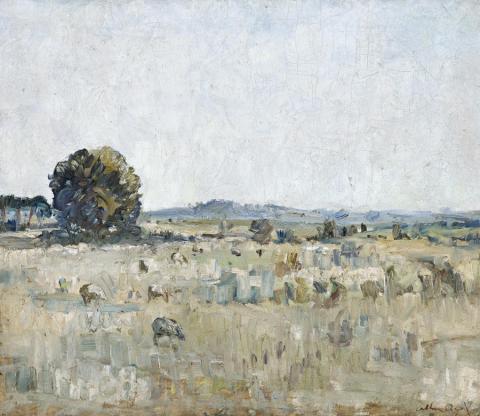SHEEP GRAZING, ROSEBUD, 1938
ARTHUR BOYD
oil on cotton gauze on composition board
55.0 x 64.0 cm
signed lower right: Arthur Boyd
signed, dated and inscribed verso: Arthur Boyd / “Sheep grazing” / 1938
Private collection
Deutscher~Menzies, Melbourne, 27 November 2002, lot 54
Private collection, Melbourne
Rebels and Precursors, Aspects of Australian Painting in Melbourne 1937–1947, National Gallery of Victoria, Melbourne, August – September 1962; Art Gallery of New South Wales, Sydney, September – October 1962, cat. 25 (label attached verso)
Arthur Boyd's early Rosebud paintings are significant, being amongst the artist's first fully-resolved and exhibited works. They offer both atmosphere and painterly dexterity, as Boyd immersed himself in the landscape of the Mornington Peninsula while living for three years with his grandfather, Arthur Merric Boyd senior, in his Rosebud cottage. Sheep Grazing, Rosebud, 1938 captures the peninsula's hinterland and closely relates to the artist's Sheep in field, 1937, in the collection of the National Gallery of Australia, Canberra, and included in the recent NGA exhibition Arthur Boyd: Agony and Ecstasy.1
Boyd's attuned vision enlivens the sparse scenery within these works. The limited palette of Sheep Grazing, Rosebud, contains nuanced colours, each of Boyd's vertical brush strokes conjuring the grasslands shifting hues. A sense of reverence within the Rosebud paintings, described by Franz Philipp as an 'unquestioning surrender to an environment'2 highlights Boyd's ability to absorb and translate through brushwork his deep responsiveness to the land.
Philipp writes, 'His is a pastoral landscape but not arcadian: parsimonious, windswept, with the high cloudy sky of the coastal region.'3 The pale sky, rendered expansively here in multi-directional impasto, lends an energy and cool light across the painting. Boyd's intense three years of painting at the peninsula was interrupted when his grandfather's health began to decline, resulting in his relocation to Murrumbeena. Yet, throughout his life he returned on occasional painting trips, the resulting 'landscapes of the later fifties stand for a reaffirmation of the artist's beginnings and of his links with a past tradition which he has always admired'.4
In Boyd's later work Peninsula Landscape, 1957, in the collection of the National Gallery of Victoria, the thickly painted sky returns, now as a thin undulating strip above the golden-beige and lilac-grey ground, again dotted with the blended forms of sheep. Boyd's captivation with this view was expressed again with the clarity and focus of his earliest pastoral works.
1. Arthur Boyd: Agony and Ecstasy, National Gallery of Australia, Canberra, 5 September - 9 November 2014
2. Philipp, F., Arthur Boyd, Thames and Hudson, London, 1967, p. 26
3. Ibid.
4. Ibid., p. 82
AMY MARJORAM
